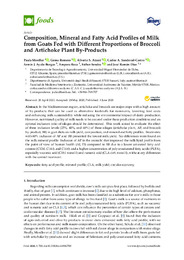Por favor, use este identificador para citar o enlazar este ítem:
https://hdl.handle.net/11000/34306Registro completo de metadatos
| Campo DC | Valor | Lengua/Idioma |
|---|---|---|
| dc.contributor.author | Romero Moraleda, Gema | - |
| dc.contributor.author | Díaz Sánchez, José Ramón | - |
| dc.contributor.author | Monllor Guerra, Paula | - |
| dc.contributor.author | Atzori, Alberto Stanislao | - |
| dc.contributor.author | Sandoval-Castro, Carlos Alfredo | - |
| dc.contributor.author | AYALA, ARMIN | - |
| dc.contributor.author | Roca, Amparo | - |
| dc.contributor.author | Sendra, Esther | - |
| dc.contributor.other | Departamentos de la UMH::Tecnología Agroalimentaria | es_ES |
| dc.date.accessioned | 2025-01-10T19:36:57Z | - |
| dc.date.available | 2025-01-10T19:36:57Z | - |
| dc.date.created | 2020-04 | - |
| dc.identifier.citation | Foods 2020, 9(6), 700; | es_ES |
| dc.identifier.issn | 2304-8158 | - |
| dc.identifier.uri | https://hdl.handle.net/11000/34306 | - |
| dc.description.abstract | In the Mediterranean region, artichoke and broccoli are major crops with a high amount of by-products that can be used as alternative feedstuffs for ruminants, lowering feed costs and enhancing milk sustainability while reducing the environmental impact of dairy production. However, nutritional quality of milk needs to be assured under these production conditions and an optimal inclusion ratio of silages should be determined. This work aimed to evaluate the effect of three inclusion levels (25%, 40%, and 60%) of these silages (artichoke plant, AP, and broccoli by-product, BB) in goat diets on milk yield, composition, and mineral and fatty profiles. Treatments with 60% inclusion of AP and BB presented the lowest milk yield. No differences were found on the milk mineral profile. Inclusion of AP in the animals’ diet improved the milk lipid profile from the point of view of human health (AI, TI) compared to BB due to a lower saturated fatty acid content (C12:0, C14:0, and C16:0) and a higher concentration of polyunsaturated fatty acids (PUFA), especially vaccenic acid (C18:1 trans11) and rumenic acid (CLA cis9, trans11), without any differences with the control treatment. | es_ES |
| dc.format | application/pdf | es_ES |
| dc.format.extent | 16 | es_ES |
| dc.language.iso | eng | es_ES |
| dc.publisher | MDPI | es_ES |
| dc.rights | info:eu-repo/semantics/openAccess | es_ES |
| dc.rights | Attribution-NonCommercial-NoDerivatives 4.0 Internacional | * |
| dc.rights.uri | http://creativecommons.org/licenses/by-nc-nd/4.0/ | * |
| dc.subject | fatty acid profile | es_ES |
| dc.subject | mineral profile | es_ES |
| dc.subject | CLA | es_ES |
| dc.subject | milk yield | es_ES |
| dc.subject | circular economy | es_ES |
| dc.title | Composition, Mineral and Fatty Acid Profiles of Milk from Goats Fed with Different Proportions of Broccoli and Artichoke Plant By-Products | es_ES |
| dc.type | info:eu-repo/semantics/article | es_ES |
| dc.relation.publisherversion | https://doi.org/10.3390/foods9060700 | es_ES |

Ver/Abrir:
foods-09-00700.pdf
292,18 kB
Adobe PDF
Compartir:
 La licencia se describe como: Atribución-NonComercial-NoDerivada 4.0 Internacional.
La licencia se describe como: Atribución-NonComercial-NoDerivada 4.0 Internacional.
.png)